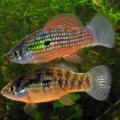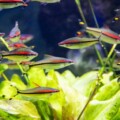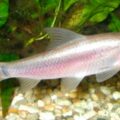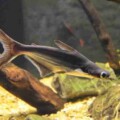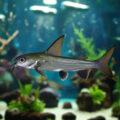Insightful care guide to help you keep the semi-aggressive Rainbow Shark in a community or solo tank, including identification, feeding, breeding and much more!
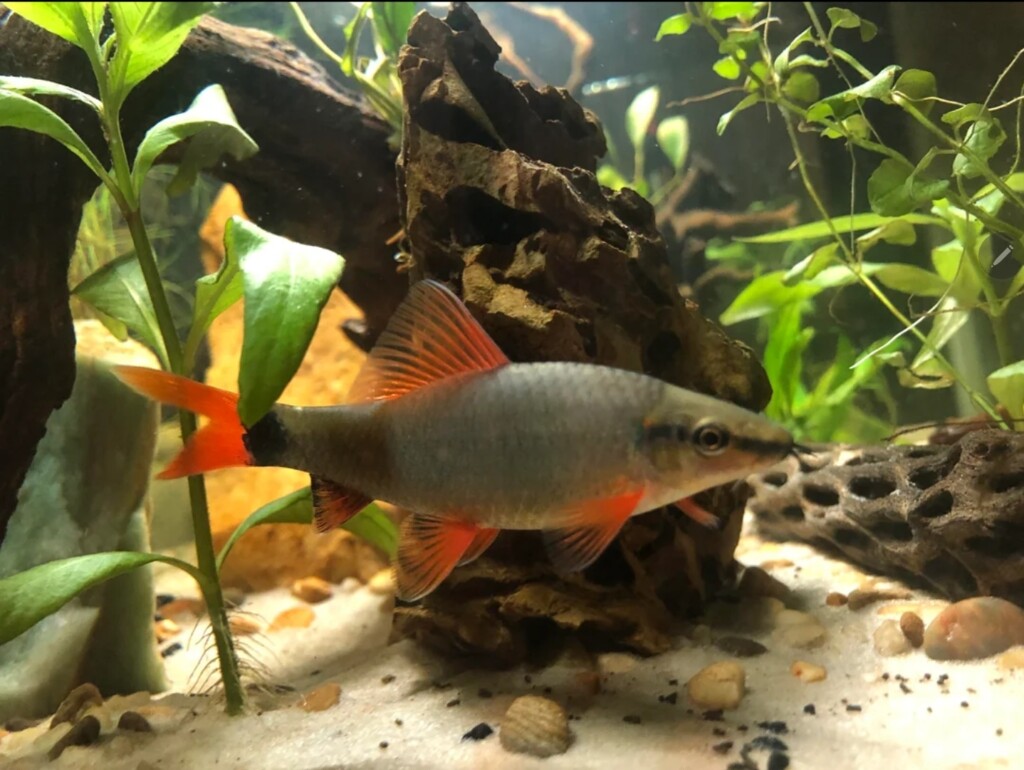
Introduction
Looking at the Epalzeorhynchos frenatum, traits like its torpedo-shaped body, smoky black shade, and red fins doesn’t explain why it’s called a Rainbow Shark. However, a closer look at its physical features and other needs will give you a better understanding of this nickname.
This Rainbow Shark overview summarises its territorial nature and specific care needs for keeping this freshwater shark species in a community tank.
Author’s Note: Check out our post on the 14 Small & Big Freshwater Pet Sharks for more Freshwater Home Aquarium compatible shark lookalikes.
Natural Origins and Behavior Insights
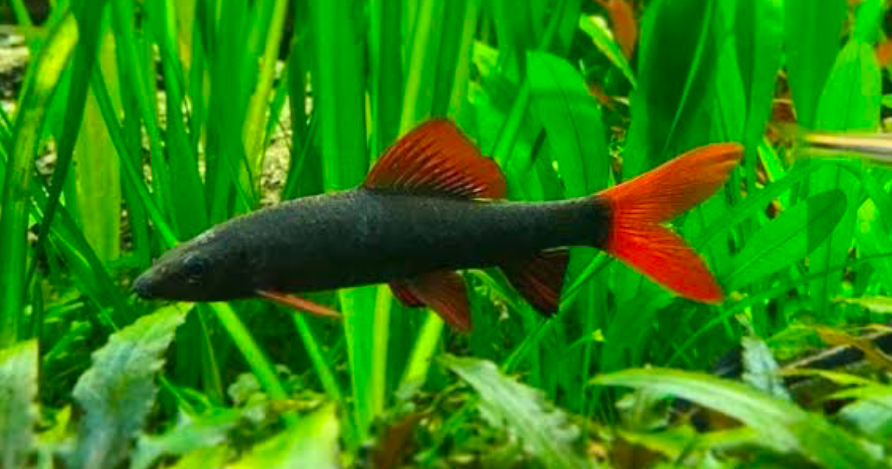
This bottom-dwelling freshwater fish comes from the river basins of Southeast Asia.
Despite being semi-aggressive and territorial, this Southeast Asian aquarium fish can be a centerpiece in a medium to large-sized tank.
You’ll, however, need specific care practices when housing them to ensure safety for the pets, their tank mates, and owners.
Ideal Aquarium Setup for Rainbow Sharks
Use this Rainbow Shark tank setup to ensure comfort and safety for your pet while keeping the environment beautiful.
It includes a recommendation on minimum tank size, layout, and compatible tank mates—plenty of hiding spaces to reduce aggression.
Tank Size
The aquarium layout for semi-aggressive fish like Rainbow Sharks should be long and rectangular with at least 55 gallons of water. The vegetation and decor shouldn’t take up space to the point of obstructing movement in the tank.
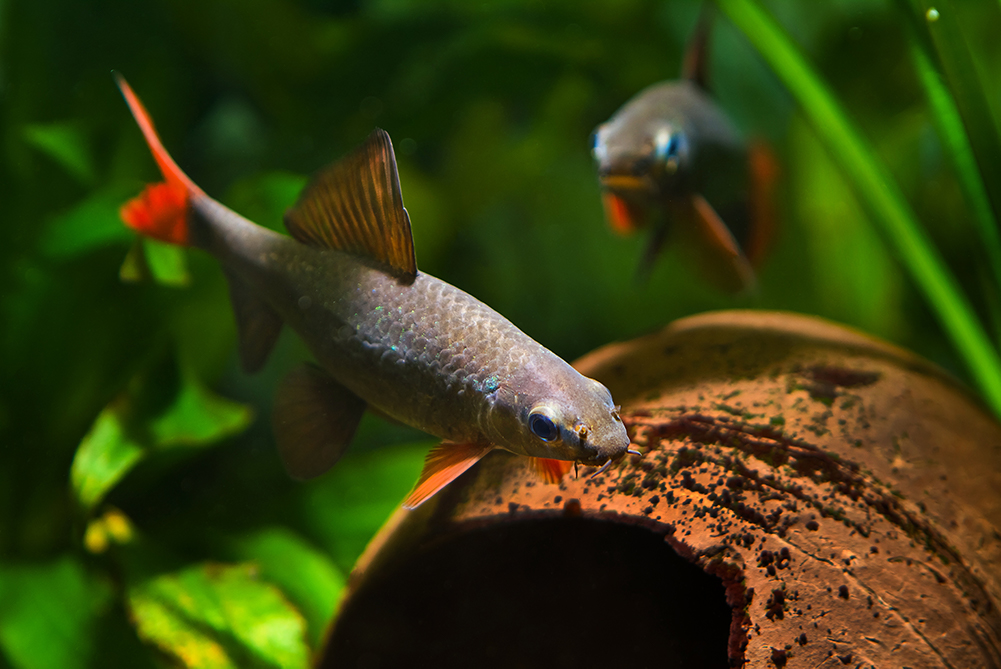
Substrate & Décor
Add open swimming areas, hiding spots, and vegetation in your large freshwater fish tank’s design.
Use smooth gravel or sand as the substrate, add caves with shells, smooth rocks for hiding areas, and driftwood for a natural aesthetic.
Filtration & Flow
Rainbow Sharks are strong enough to withstand moderate to strong water flow like their natural river habitat. But ensure it’s not too fast or strong to sweep the fish away.
Appearance and Physical Characteristics
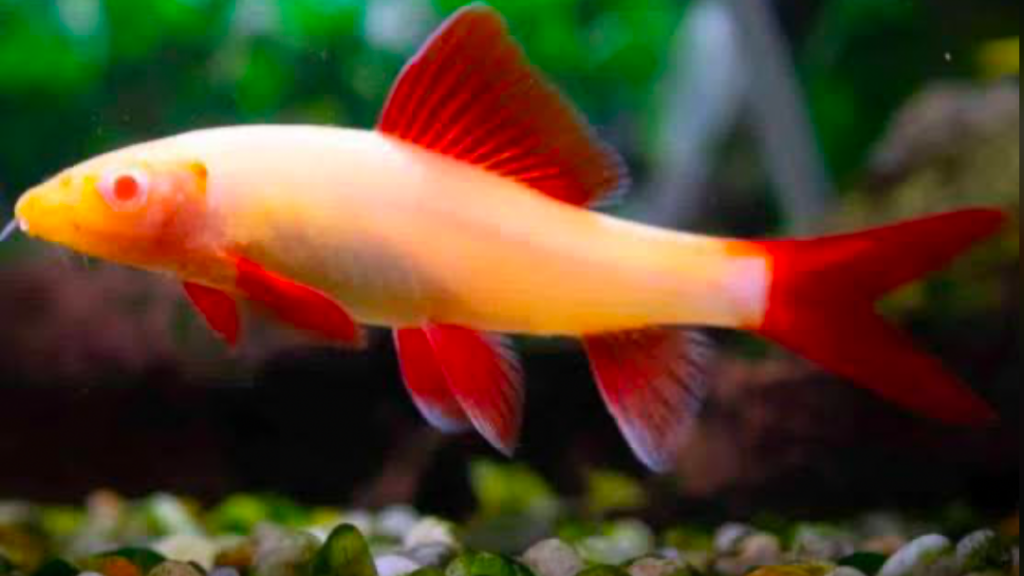
Due to having a streamlined shape, this freshwater aquarium centerpiece fish can swim in waters with strong currents. They also have a jet-black body and bright red or orange fins that’ll arrest the attention of any observer.
Juveniles are more vibrant than adults and genetic mutations cause color variations, like albinism.
Color Pattern
Besides the charcoal gray variant of this species, there are also rare albino Epalzeorhynchos frenatum worth your attention. The albinos have different colorations but similar traits like aggression and territoriality, except for their sensitivity to light.
The Red-Tailed Black Shark (Epalzeorhynchos bicolor) is commonly mistaken for Rainbow Sharks. Both have bodies that are smoky black, however Rainbow Sharks have red fins and tails while only the Red-Tailed Black Shark’s tail fin is red.
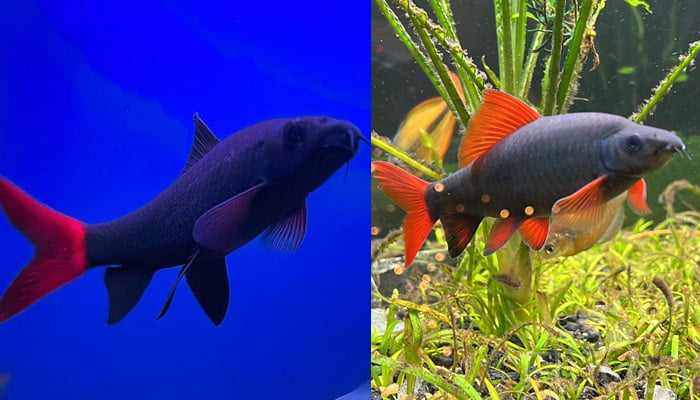
Epalzeorhynchos bicolor is also much more aggressive in comparison to the more docile and tankmate compatible Epalzeorhynchos frenatum.
Unique Traits
Besides the unique Rainbow Shark fin coloration that’s different from their bodies, this species are rapid swimmers who prefer to live alone.
Observe their fin coloration, though, because the red intensifies with age.
Feeding Rainbow Sharks: What to Include in Their Diet
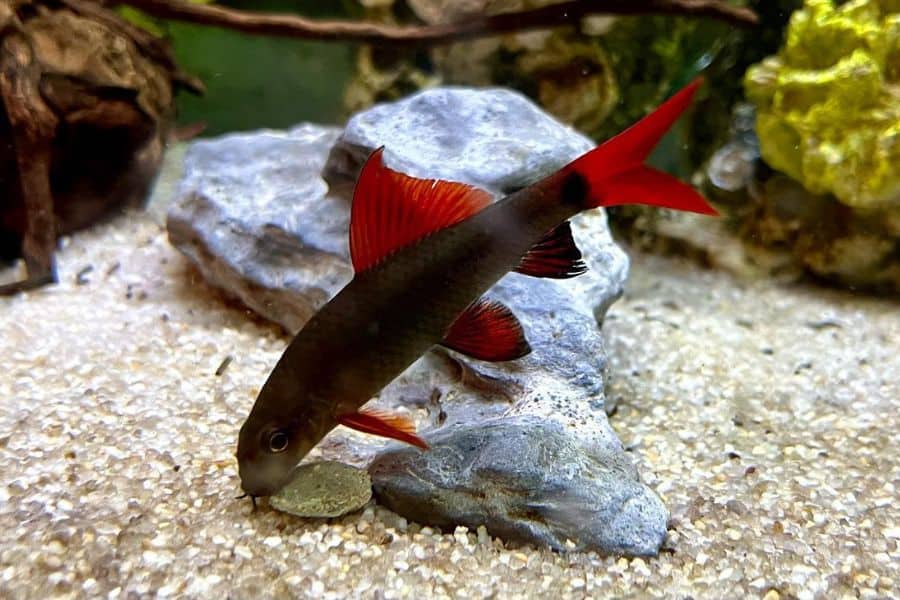
Rainbow sharks feed on classic omnivore freshwater fish diet like pellets, live foods, and veggies. I recommend inking pellets, algae wafers, and fresh vegetables because they’re bottom dwellers. Highlight their scavenging tendencies and importance of a balanced protein-vegetable mix.
Feeding Frequency
This Rainbow Shark feeding guide helps you provide the necessary nutrients for your pets to grow healthy. Feed them once or twice daily in controlled portions they can finish within 2-3 minutes.
Diet Suggestions
You must maintain a balanced diet for aquarium sharks despite them being scavengers. If you leave them alone, they won’t get all the nutrients they need, so add the following to their meals
- Sinking pellets
- spirulina
- zucchini
- bloodworms
Author’s Note: For more on feeding your aquatic pets check out The Ultimate Guide to Fish Food: Pros and Cons & Best Choices!
Tank Mates: Compatible and Conflict-Prone Species
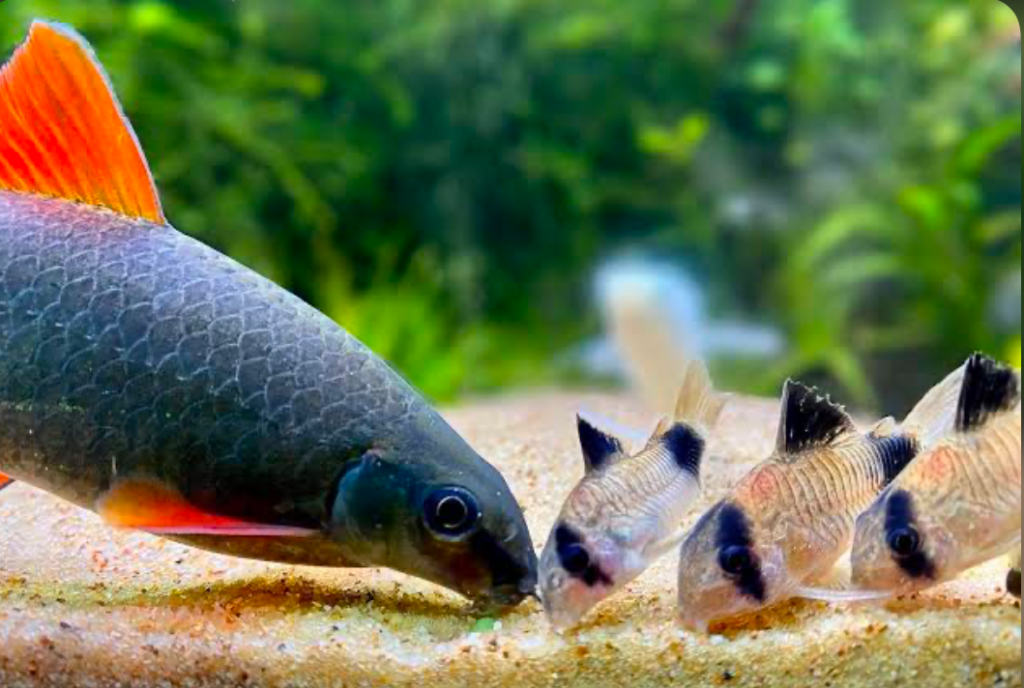
Choosing other semi-aggressive community fish for your Rainbow Shark can be tricky because you must balance several temperament quirks with environmental compatibility.
Find fast-swimming species that can coexist with your pets because they have similar environmental and dietary needs.
Compatible Species
Compatible Rainbow Shark tank mates include Giant danios, barbs, and rainbowfish. They’re large enough to not be bullied while adding beauty to the aquarium.
Species to Avoid
You must avoid other bottom-dwellers, slow fish, or species with similar body shapes that may trigger aggression. Examples of fish to avoid with Rainbow Sharks include Red-tailed sharks, cichlids, slow swimmers, or tiny bottom dwellers that can become prey.
Breeding Behavior: Challenges in Home Aquariums
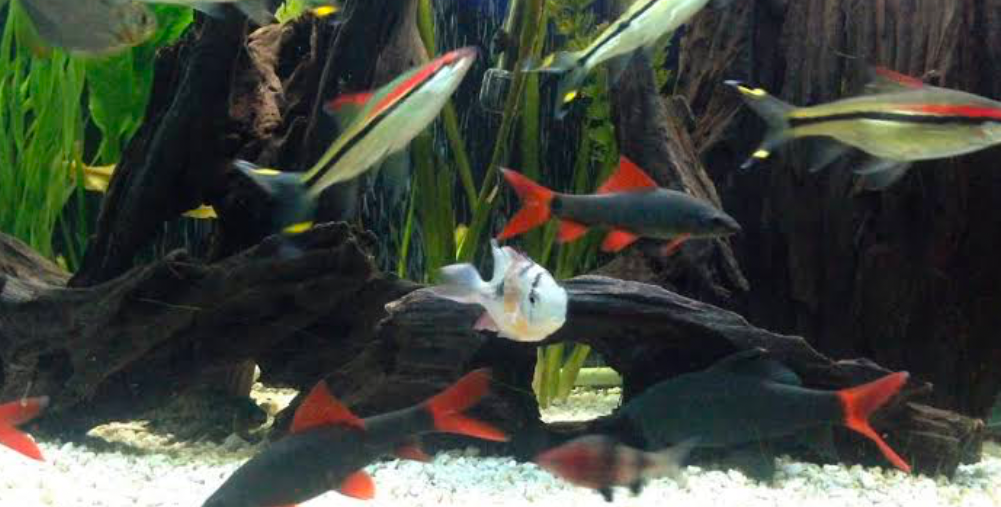
Rainbow Sharks rarely breed in home setups due to territoriality and environmental challenges. Note that most available specimens are commercially bred with hormone stimulation.
Breeding in Captivity
You’ll face some captive breeding challenges like stunted growth, discomfort, and behaviors like fighting for territories. So, you must provide commercial conditions to ensure asuccessful freshwater shark reproduction.
Sex Differences
Start by successfully distinguishing between male and female Rainbow Shark fish. Males have brighter red fins with slender gray lines on their tail fins and smaller bodies, while females are larger with faint red fins.
Other Rainbow Shark breeding info you need for successful reproduction include
- Maintaining pristine water quality
- Providing protein-rich food for healthy development
Health Issues and Maintenance Tips
Failure to provide adequate food and shelter will lead to Rainbow Shark health problems like stress from cramped tanks, fungal infections, and aggression injuries.
Preventative Practices
You can reduce the risk of stress in semi-aggressive fish like Rainbow Shark by providing regular water changes, compatible tank mates, hiding spots, and safe substrates, and spacious layouts.
Signs of Stress
Following the instructions in this aquarium fish care guide almost guarantees a sickness-free life for your pets, but note these signs of stress in case you falter in your duties:
- Faded colors
- Fin damage
- Hiding behavior more than normal
Lifespan and Long-Term Considerations
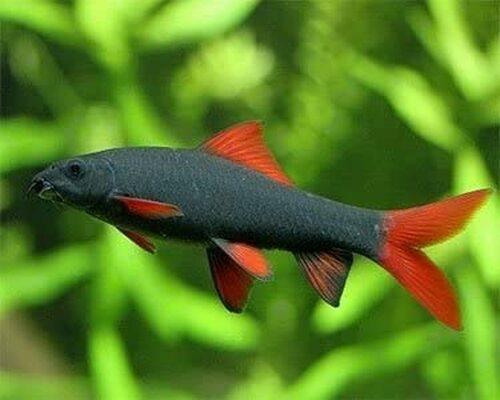
Rainbow Sharks can live up to 8 years or more with proper care but you’ll need long-term planning, like tank upgrades and behavioral monitoring as they age to ensure they reach their maximum potential.
Growth & Size
This species is typically at least 6 inches long so prepare for a freshwater aquarium fish growth by increasing your tanks size as your pet extends and grows.
Tank Longevity
You can extend a Rainbow Shark’s lifespan with consistent conditions as provided above and adequate space to thrive, whether for swimming or lounging.
Feeding, breeding simulations, and species selection are all part of Epalzeorhynchos frenatum long-term care. So, follow the rules in this guide strictly.
Conclusion: A Bold Addition for the Experienced Aquarist
Because of their semi-aggressive nature and size, Rainbow Sharks are aquarium fish better suited for experienced keepers. However, if you’re a beginner enthusiast, this Rainbow Shark care summary is comprehensive enough to help you get started.
Reading this semi-aggressive freshwater fish profile, you can tell it’s a visually impressive and active species worth the effort.
So, what are you waiting for? Start your Rainbow Shark aquarium today and share your experience with us in the comment section!

